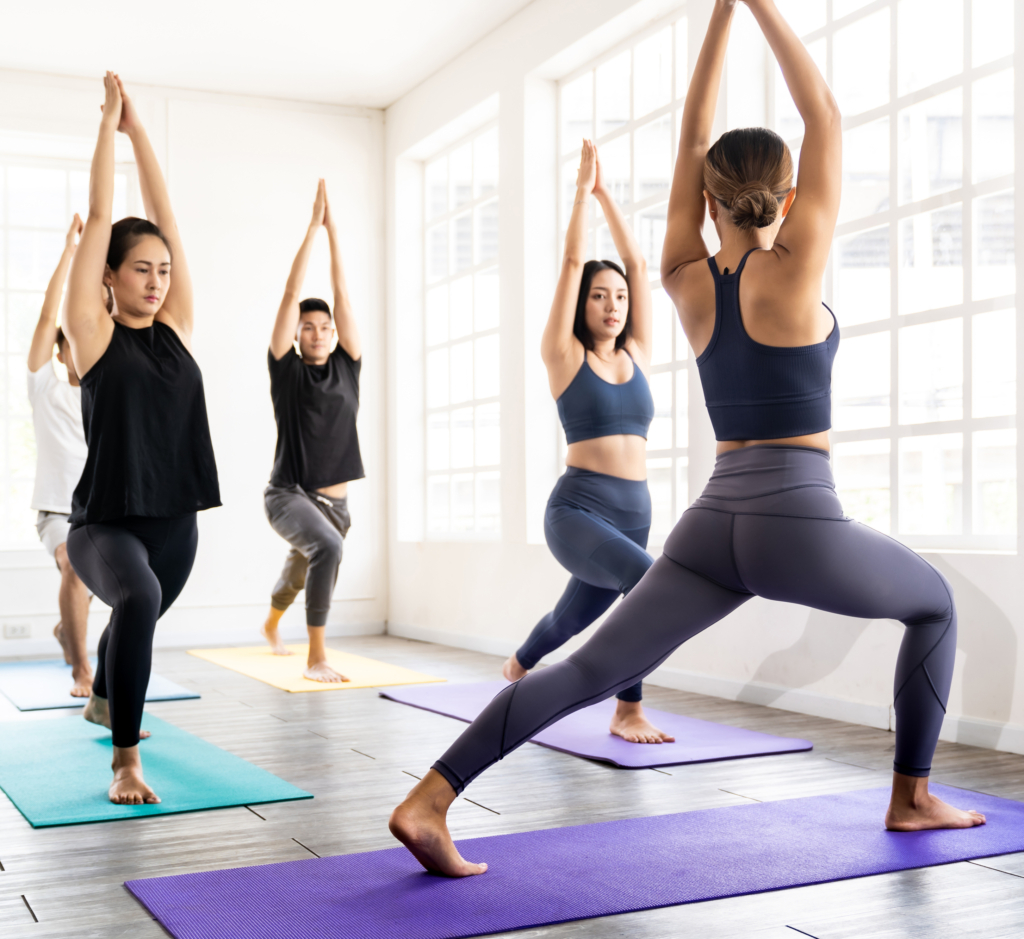Excited to guide students toward improved strength, flexibility, balance, and mind-body connection after attaining your Yoga Instructor Certification?
That’s terrific news, but how exactly do you get started and land your first yoga teaching job? That’s what this article is for. Below, discover a six-step process that’ll help get you started on a fulfilling career.
#1: Decide How You Wish to Teach Yoga
First things first: How do you wish to teach yoga?
Part-Time or Full-Time?
Will you teach full-time or part-time? While this decision hinges on many individual factors (e.g., schedule, need for benefits like health insurance, and lifestyle preferences), a key consideration is likely your current financial standing.
In the early stages of your career as a yoga instructor, you may struggle to earn a sustainable income—especially since most places, from gyms to studios to corporate gigs, pay an hourly rate per class, and you likely won’t be assigned many classes at the very beginning.
If you have sufficient savings to tide you through the initial stages, you could go all-in on yoga as your primary source of income (i.e., treat it as a full-time job).
But if you don’t, going part-time might be a more sensible option. This way, you’ll at least have multiple streams of income (e.g., from another part-time or full-time job), providing you with a wider safety net.
Where Will You Teach?
Beyond deciding if you should teach yoga part-time or full-time, you should also choose where you wish to conduct your lessons. Here are the three most common teaching “locations” for yoga instructors:
- Gyms: A gym is a typical first landing spot for yoga instructors fresh from teacher training. There’s a built-in membership of students, which means you’ll get plenty of people in class with a wide range of bodies and ages. This provides a fantastic opportunity to hone your teaching skills, and quick.
- Studios: Unlike gyms, yoga studios are more likely to adhere to a particular yoga approach and style of class. It’s thus a good idea for you to do a “pre-screening” before approaching any studio. This ensures you’re the right fit for what the owners and their clientele are looking for.
- Online: If there’s anything we’ve learned in the past two years, it’s this: Virtual fitness is here to stay. Many gyms and studios are now offering online yoga classes, too, and you could take advantage of that if you’re eager to teach on platforms beyond face-to-face classrooms.
Note that there are plenty of other places where you could also teach yoga. Examples include community centers, school gymnasiums, dance studios, hotels, and even the great outdoors. So, feel free to think big!
#2: Create Your Personal Brand as a Yoga Instructor
There are plenty of yoga instructors around: Why should a particular gym, studio, or client hire you over others in the field? Put simply, you’ll have to find a way to stand out from the competition.
One method would be to set a clear, unique vision for your work as a yoga instructor. Ask yourself the following questions:
- What’s my “why”? Consider and list the experiences you have had that brought you to yoga. Was it a pregnancy, a desire to get in shape, a need for downtime and centering, or something else? Then, think about what kind of teacher this backstory has set you up to be (e.g., you wish to focus on using yoga to help people return their busy, distracted minds to a calm state).
- Who’s my ideal audience? Envision your ideal audience. Who do you naturally relate to? Is it athletes, pregnant individuals, children, seniors, office workers, etc.?
- What problems do they have, and how can I help? Think about patterns your target audience may develop in mind and body. How can these patterns become a problem? And more importantly, how can yoga solve that problem?
Here’s an example of how you could put everything together:
“As a mom of two, I understand the trickiness of staying physically active through pregnancy and parenthood. That’s why my classes emphasize efficiency and intention. Careful thought goes into every sequence to maximize the number of poses per session without overwhelming students—showing them it’s possible to fit movement into their daily lives in a way that makes sense for them, despite their changing bodies and/or packed schedules. There’s plenty of attention to the core, the hips, and using the body, breath, and mind to focus.”
How to Communicate Your Vision
How would anyone know your vision if you don’t put it out there? Consider doing the following to make your vision known:
- Build a website: You don’t need a fancy website. Even a single page with a smiling photo, your schedule, a brief bio (you can adapt it from your vision), and your contact information will suffice. If you need more guidance, click here to learn more about how you could build a website you’d be proud of.
- Explore content marketing: Create helpful, valuable, and relevant information for potential students in a way that’s aligned with your vision. For example, if your target audience is postnatal individuals, you could develop resources on common pelvic health issues associated with pregnancy—and how yoga could help. Find a step-by-step guide to getting started with content marketing here.
#3: Chart a Course for Students
You’re likely raring to land your first job as a paid yoga instructor at this stage. But there’s still one last thing to do: planning a sample class.
This gives any potential employer (gyms, studios, or individual clients) the chance to evaluate your suitability for their goals, training experience, and needs. Here are a few tips to keep in mind as you go about class planning:
- Remember your intention as a yoga instructor: Visualize your ideal students and what they need from the practice. This will guide you as you create your sequence.
- Keep it balanced: Slot in moves that’ll take the spine in every direction: forward and back, left and right, round and round. Also, ensure your plan doesn’t skew too much toward only standing, sitting, or reclining. Tweak your plan until it feels organically balanced. Remember to account for appropriate transitions between poses as well.
- Plan for different bodies and injuries: To illustrate, poses like the cat/cow may not be suitable for clients with wrist issues. A workaround is to plan for an alternative where students could place their forearms on blocks instead. Taking the time to pre-plan modifications helps create an accessible space where everyone can enjoy a safe and supportive yoga practice.
- Practice, practice, practice: You can’t simply put your plan down on paper; gyms and studios will likely request you to run through a class in real-time so they can judge your teaching and time-management skills. That’s why you need to practice your sequence to be sure it’s appropriate for the time you’ve planned for it (e.g., if you can indeed complete everything within 45 minutes).

Explore AFPA’s Yoga Instructor Certification Today
Gain the skills, resources, and confidence to integrate yoga into your life and career.
#4: Approach Gyms, Studios, and Potential Clients
You’re finally ready to approach gyms, studios, and individual clients! Here are a few different ways you could go about it:
- Drop in and ask at the desk (gyms and studios): Start by looking at the gym/studio’s website to see if there are instructions to apply. If not, drop in and ask who programs groups fitness and the best way to contact them at the desk. Meet them in person if you can, introduce yourself, and if they’re interested, get their contact information so you can follow up with more details on your experience and availability.
- Send an email (gyms, studios, and individual clients): If you can’t meet in person, send an email introducing yourself, briefly detailing your experience and availability, and offer to come by in person for an interview at their convenience. Keep your language relatively formal. And if you have your yoga website ready, include a link under your name or as part of your signature file.
- Leverage your platforms (individual clients): Maybe you’ve already gained a few subscribers/followers on your newsletters or social media platforms. This is an excellent opportunity for you to publicize your services. Let’s say you’re on Instagram, for instance. You could simply publish a post detailing your schedule—and for followers to reach out if they’re interested in taking your classes.
Cover Your Legal Bases Before Working with Any Students
Note, Before you start working with any students, ensure you’ve covered your legal bases. Here are a few things that’ll help you manage your liability if a student is hurt in your class and decides to sue:
- Waivers and disclaimers: Any student you teach should sign a waiver and release of indemnification acknowledging that they are taking care of themselves in the class—and waiving their right to sue you. This should be signed on paper or electronically at the initial contact with the student, then filed somewhere safe for your reference.
- Liability insurance: Gyms and studios typically have their own liability insurance but note that that covers their liability obligation—not yours. In the event of a suit, the gym/studio’s insurance company can be quick to cast the blame on you. Thus, it’ll be wise for you to carry your own liability insurance.
- Incorporation and separate accounts: Incorporating as an LLC or S-Corp will provide you with an additional liability veil. A suit would, theoretically, go against you as the corporation’s owner and hold against its assets, not against you as an individual with personal bank accounts and assets (e.g., your home and car). This is another reason to keep your yoga income in a separate bank account under the name of your business.
#6: Continue to Take Classes
Landing your first job as a yoga instructor is excellent, but there’s also the matter of keeping it so you can improve your skills and, if desired, earn a sustainable income from doing what you love. And for that, you’ll need to continue developing your craft.
How? By taking a wide range of yoga classes from different teachers. This will help you:
- Get inspiration: Choose a wide range of teachers you’ll study with occasionally; this ensures that your understanding of yoga isn’t just deep but also broad. Every teacher has something to offer you. Note what you like and dislike about each class—this knowledge may help guide your future classes.
- Find mentors: When you find an instructor you admire, whether in a regular class or online, introduce yourself. Ask about their background and path. You might find ideas in this teacher’s experience to guide your journey. And if the time is right, you could also ask whether they would be interested in mentoring you.
- Know more gym/studio owners: Most gym and studio owners prefer to hire instructors who practice in their spaces. So, go out there and expand your connections. Who knows what opportunities will come your way?
Takeaway
Landing your first teaching job as a yoga instructor doesn’t have to be a daunting experience. Take it one step at a time.
Decide how you wish to work, clarify your vision, plan a sample yoga class to showcase your expertise, and you’re all set to impress potential employers and individual clients before you know it. Just don’t forget to cover your legal bases before conducting that first paid class!
And just one final note: Broadening your skillsets could help make your training more comprehensive and helpful, enhancing your value and desirability as a yoga instructor.
Here are three great upskilling opportunities to consider:
- MS Fitness & Wellness Specialist Certification
- Prenatal and Postnatal Fitness Specialist Certification
- Certified Personal Trainer

Explore AFPA’s Yoga Instructor Certification Today
Gain the skills, resources, and confidence to integrate yoga into your life and career.



